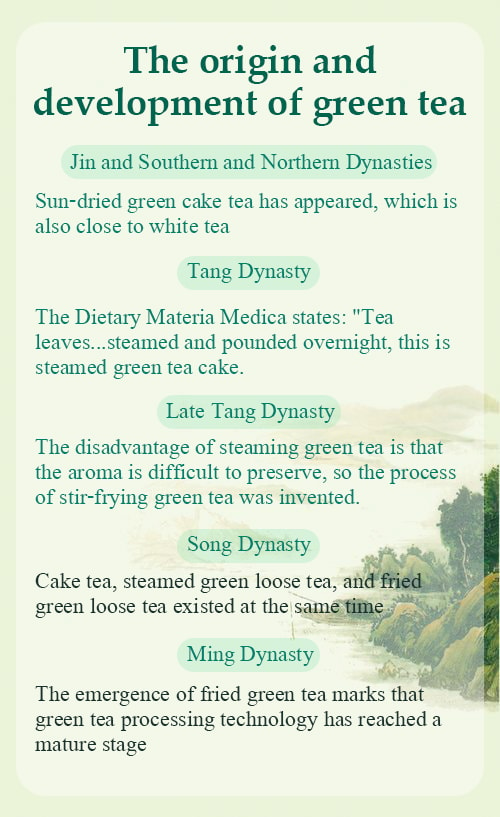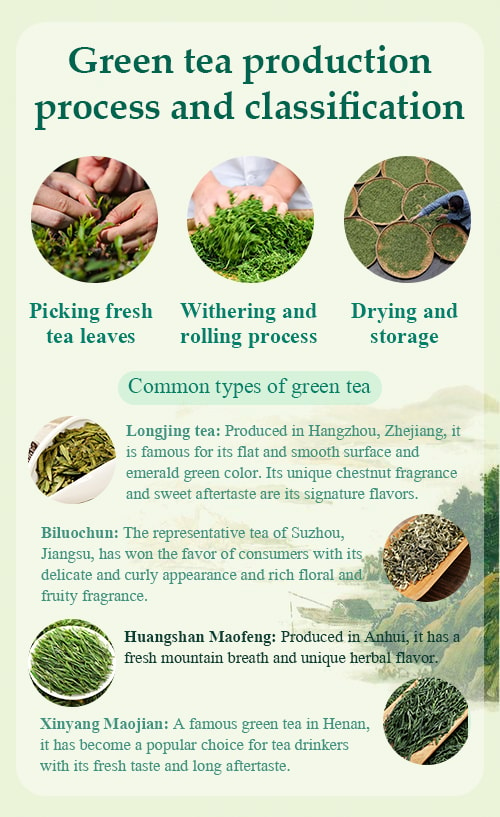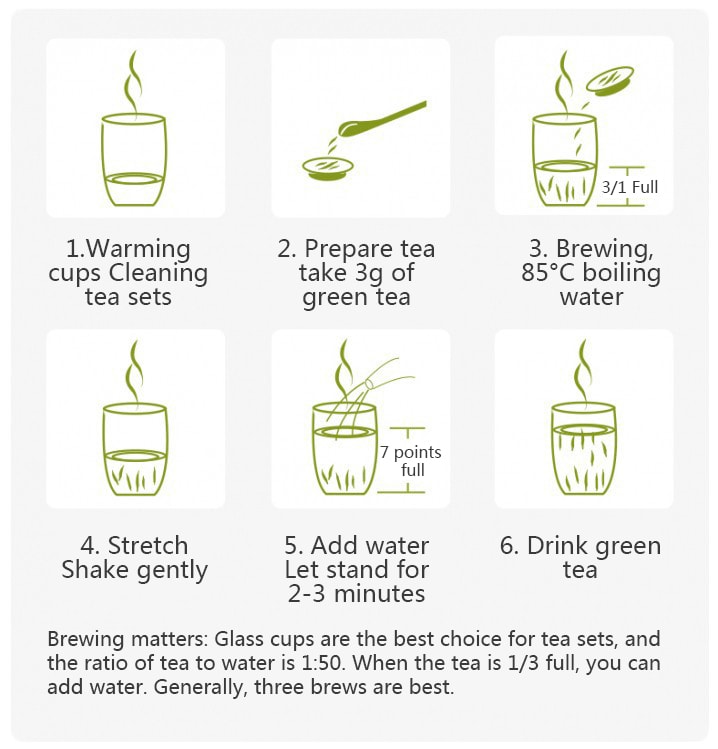
Where Did Green Tea Come From? ——Exploring the Origin and Health Appeal of Chinese Green Tea
liujiehangShare
Green tea is one of the most representative beverages in Chinese tea culture. Its refreshing taste, herbal aroma and rich health benefits are loved by tea drinkers around the world. Green tea consumption dates back to the Han Dynasty when it was primarily used for medicinal purposes, and it evolved during the Tang Dynasty into a cultural symbol associated with pleasure and social status through the formalization of tea ceremonies.
The Origin and Historical Background of Green Tea

The long history of Chinese green tea
The history of Chinese green tea can be traced back thousands of years. As early as the Tang Dynasty, tea changed from a medicine to a kind of enjoyment and became a drink for scholars and monks. Legend has it that Buddhist monks drank green tea to refresh themselves during their missionary work, thus popularizing this natural drink. The production and drinking methods of green tea are recorded many times in ancient books, which not only shows the special status of green tea in Chinese culture, but also lays the foundation for the development of tea art in later generations.
Inheritance and development of tea culture
In traditional Chinese culture, drinking tea is not only a daily habit, but also a way to cultivate one's character. Literati and scholars of all dynasties often use "drinking" and "tasting tea" to express their moods and emotions. Green tea, as a typical representative of Chinese green tea, has become a frequent guest on the tea table with its fragrance and elegant taste. From ancient times to the present, tea culture has been integrated with philosophy, art and health concepts in its continuous inheritance, and has become a part of the Chinese nation's lifestyle.
Green tea production process and classification
Picking fresh tea leaves
The production of high-quality green tea begins with the picking of fresh leaves. Generally speaking, early-picked tender leaves are rich in natural vitamins, amino acids and tea polyphenols, and are the best raw materials for making high-quality green tea. Tea farmers usually pick green tea leaves in the early morning to ensure that the freshness and nutrients of the tea are not destroyed. It is essential to heat and dry the green tea leaves quickly to prevent oxidation, which changes its color and flavor.
Withering and rolling process
After the tea leaves are picked, they must be withered quickly. Withering is to destroy the enzyme activity in the tea leaves by high temperature, prevent the oxidation of chlorophyll, and thus maintain the bright green color and fresh taste of green tea. The traditional pan frying method is a common withering method. By quickly frying the tea leaves in a high-temperature iron pan, the tea leaves lose water quickly and lock in the original aroma of the tea leaves. The subsequent rolling process makes the tea leaves more uniform in shape, which is convenient for subsequent drying and storage.
Drying and storage
Drying is a crucial step in the production process of green tea, which not only determines the final shape of the tea, but also affects the color and aroma of the tea soup. The combination of traditional sun drying and modern low-temperature drying technology can not only preserve the natural nutrients of the tea, but also make the tea soup clear and bright. In order to ensure the freshness and flavor of the tea, it needs to be placed in a sealed container and stored in a dry, cool and dark place to avoid the effects of direct sunlight and humid environment on the tea. Additionally, storing green tea in an airtight container or refrigerator can prevent oxidation and maintain its flavor.
Types of Green Tea
There are many varieties of Chinese green tea, each with its own unique flavor and production process.Common ones include:
- Longjing tea: Produced in Hangzhou, Zhejiang, it is famous for its flat and smooth surface and emerald green color. Its unique chestnut fragrance and sweet aftertaste are its signature flavors.
- Biluochun: The representative tea of Suzhou, Jiangsu, has won the favor of consumers with its delicate and curly appearance and rich floral and fruity fragrance.
- Huangshan Maofeng: Produced in Anhui, it has a fresh mountain breath and unique herbal flavor.
- Xinyang Maojian: A famous green tea in Henan, it has become a popular choice for tea drinkers with its fresh taste and long aftertaste.
Each of these Chinese green teas has its own advantages. Whether it is whole green tea or loose leaf green tea, it can provide tea drinkers with unique taste experience and health benefits.
In addition to Chinese varieties, popular Japanese green teas such as Sencha, Matcha, and Gyokuro are well-regarded among tea enthusiasts for their unique flavor profiles and cultivation methods.

Health Benefits of Green Tea
Antioxidant and anti-aging:Green tea is rich in tea polyphenols, vitamin C and other natural antioxidants, which can neutralize free radicals in the body, delay cell aging and play an anti-aging role. A large number of systematic reviews and observational studies have shown that moderate consumption of green tea can prevent diseases caused by oxidative stress to a certain extent.
Improve cardiovascular health:Studies have shown that the active substances in green tea can help lower blood pressure and improve blood lipid levels, thereby reducing the risk of heart disease and cardiovascular disease. Green tea's natural ingredients can promote blood circulation and keep the heart healthy, so drinking a cup of high-quality green tea every day is very beneficial to maintaining cardiovascular health.
Promote digestion and regulate intestinal flora:The polyphenols in green tea not only help digestion, but also regulate intestinal flora and promote intestinal health. It can inhibit the growth of bad bacteria, while helping to maintain the balance of beneficial bacteria, providing the human body with a healthy digestive system environment.
Similarities and Differences between Chinese and Japanese Green Tea
Differences in production process
Chinese green tea and Japanese green tea have different process. Chinese green tea is usually roasted (pot-baked) or sun-dried, shaded, etc. to keep the natural aroma and grassy taste of the tea leaves. Japanese green tea is mostly steam-baked, which can lock in the moisture and ingredients of the tea leaves better, so the tea soup is bright green and refreshing.
Also, the caffeine content varies among Chinese teas, like Green and Black Tea, due to the oxidation process. The traditional Chinese tea-making method called Gong Fu Cha is said to reduce caffeine and increase flavor.
Flavor and taste comparison
Due to different processing techniques, the flavors of green tea in the two countries are also unique. Chinese green tea usually has a fresh grassy fragrance, slight bitterness and sweetness, while Japanese green tea tends to be fresh, soft, and has a unique seaweed flavor. No matter which type of green tea, its unique production method has formed its own unique plant flavor and healthy charm.
Differences in consumption habits
In terms of tea drinking culture, Chinese green tea emphasizes the traditional brewing of loose leaf tea and the drinking experience of multiple soakings, reflecting a strong tea cultural heritage. Japanese green tea is more suitable for the fast-paced daily life, and its tea powder and bottled tea beverage forms are more convenient and popular among modern consumers. Nevertheless, the traditional green tea culture has a long history in both countries, and both emphasize the effect of drinking tea to regulate the body and mind.
How to brew green tea correctly
The correct brewing method can not only retain the nutrients of green tea to the greatest extent, but also allow you to enjoy the unique taste of green tea.

- Choose the right water temperature: The key to brewing green tea is the water temperature, which is generally 70-85℃. If the water temperature is too high, the tea will be bitter, and if the water temperature is too low, the aroma and effective ingredients of the tea cannot be released, so the right water temperature can balance the freshness and bitterness of green tea and make the tea soup smoother.
- Control the soaking time: The brewing time of green tea is generally short, usually 1-2 minutes. When brewing for the first time, the tea releases the most aroma and vitamins; after brewing many times, the aftertaste and sweetness of the tea will gradually appear. The soaking time can be adjusted appropriately according to personal taste, but it should not be too long in general, so as not to destroy the freshness of the tea.
- Pay attention to the ratio of tea leaves to water: The correct ratio of tea leaves to water can better show the natural flavor of green tea. Generally, it is recommended to use about 2 grams of tea leaves and about 150-200 ml of hot water per cup of green tea. The brewing of loose leaf green tea and whole leaf green tea is slightly different, and can be adjusted according to the type of tea and personal preference.
- Choice of brewing vessel: Using a transparent glass or porcelain cup can more intuitively observe the stretching state of the tea leaves in the water, which is also part of the experience of green tea aesthetics. During the brewing process, it is recommended to use a filter to ensure the clarity and purity of the tea soup, ensuring that every sip of tea can be presented in the best state.
Taste the culture and health wisdom of Chinese green tea
Through the origin, production process, health benefits and comparison of Chinese and Japanese green tea, I hope you have a deeper understanding of Chinese green tea. Every cup of green tea is a gift from nature and a combination of ancient wisdom and modern health concepts. Whether you like traditional loose leaf green tea or modern green tea supplements and extracts, you can find peace of mind and physical health in the process of tea drinking.
Now pick up a cup of fresh green tea, smell the unique aroma from the East and start a healthy, natural and culturally rich tea drinking journey! When you choose Chinese green tea, you are not only drinking a beverage but also experiencing a cultural heritage and life wisdom that transcends time and space. The various cultivation methods and environmental factors of tea plants such as the time of year they are plucked, how they are pruned and the surrounding environment all play a big role in determining the final taste of the tea.









